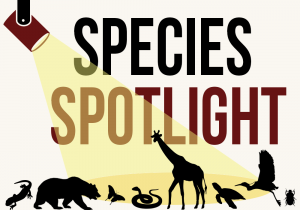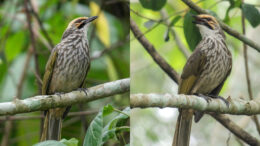Coveted for its rich, melodious song, the critically endangered straw-headed bulbul continues to decline across its range due to relentless trapping for the cage-bird trade. Lax enforcement of existing laws has made the problem worse.
Species name and description:
 The straw-headed bulbul (Pycnonotus zeylanicus) is a large, brown bird with a yellow crown and cheeks, thick white streaks on its breast, and two prominent facial stripes. It’s best known for its bubbling, lyrical song.
The straw-headed bulbul (Pycnonotus zeylanicus) is a large, brown bird with a yellow crown and cheeks, thick white streaks on its breast, and two prominent facial stripes. It’s best known for its bubbling, lyrical song.
Where it’s found:
The straw-headed bulbul is a Sundaic species primarily found in the lowland scrub and woodland of southeast Asia, including secondary and disturbed forests, most often near rivers and other open water bodies.
Until the latter part of the 20th century, it was widespread in lowland riparian areas from Tenasserim, Myanmar, south through peninsular Thailand and peninsular Malaysia and Singapore to Sumatra, Java and Kalimantan, Indonesia, Brunei and Sabah and Sarawak (Malaysia). Common throughout its range in the 1950s, it is now extinct in Thailand and most likely extinct in Myanmar and Java; it’s very close to extinction on Sumatra, as well.
The bird now lives wild only in Brunei Darussalam, Indonesia, Malaysia, Myanmar and Singapore. Singapore is considered a stronghold — the only population that appears to be increasing — but elsewhere extirpations are evident throughout the bulbul’s range. In Indonesia it likely survives only in remote parts of Kalimantan. Surviving populations in Malaysia and Singapore are under severe threat from poaching for the cage-bird trade.
IUCN Red List status:
Major threats:
The straw-headed bulbul is among Asia’s most threatened songbirds due to seemingly unabating demand for the cage-bird trade. The culture of bird-keeping is strong in some Southeast Asian countries, particularly Indonesia, and this bird’s rich melody makes it very popular in songbird competitions and with hobbyists. The demand has resulted in intense trapping of the birds, which are then sold in bird markets, and more recently, online using social media platforms. Demand from the trade has devastated bulbul populations.
As wildlife traders increasingly weaponize social media by advertising protected species for sale, national legislation lags in many range states. Malaysia, for instance, still does not have laws pertaining to cyber wildlife crime and online wildlife trade remains a convenient loophole, despite being flagged as an issue by conservation organizations.
Wild populations are increasingly difficult to locate, and as numbers of specimens in the wild decrease, the prices commanded by traders have increased, putting further pressure on the remaining birds.
Notable conservation programs or legal protections:
While the species is protected in most of its extant range states, it is not currently protected in Indonesia. Protecting it in Indonesia is of critical urgency, as the country is its most significant consumer. In June 2018 the Indonesian government launched a revised list of protected species to include the straw-headed bulbul, previously only protected by a zero-harvest quota. But this positive conservation action was tragically short-lived. The Indonesian government buckled under pressure from a coalition of bird hobbyists and traders and removed the straw-headed bulbul and four other songbird species from the protected species list in August 2018 — ironically, the very same month that the species was categorized as critically endangered on the Red List.
View this post on Instagram
A zero-harvest quota remains in place in Indonesia, prohibiting capture and trade. While in theory this should be adequate protection, in reality no penalties for transgressions are evident, rendering the policy completely ineffective.
Breeding for commercial sale of this species is legal in Indonesia. But allowing trade in captive-bred birds while failing to adequately monitor their operations, and not closing the open bird markets found throughout the country, simply creates a convenient loophole for wildlife laundering.
My favorite experience:
Eighteen years ago I had the privilege of hearing the song of the straw-headed bulbul for the first time, just minutes away from where we lived in Malaysia. I was fortunate to observe them in that same forest reserve several times afterward, as well as by the rivers in Malaysia’s premier national park, Taman Negara. But it has been years since we have seen or heard them. I know it’s not too late for the species in Malaysia — and on a rather personal note, I hope that one day, my daughters will see and hear the song of wild straw-headed bulbuls here.
What else do we need to understand or do to protect this species?
First and foremost, Indonesia should reinstate full legal protection and put effective measures in to place to ensure breeders are not laundering wild-caught birds into the trade under the guise of being captive-bred.
Cross-border commerce also needs to be addressed. To accomplish this, the species should be uplisted from Appendix II to Appendix I of the Convention on International Trade in Endangered Species of Wild Fauna and Flora (CITES), which would ban all international trade. This would also strengthen efforts made by range states to prevent illegal international trade and further highlight the urgency of the issue.
Protecting where these birds live will also help. The straw-headed bulbul’s habitat is shared by other, higher-profile species, such as tigers, orangutans and elephants. As such, existing efforts to protect those species could be taken advantage of to better protect the birds. Patrols should be made aware of the straw-headed bulbul and its protection status and be on the lookout for bird trappers and traffickers, especially in areas where this highly threatened species still persists.
View this post on Instagram
Trade in physical and online markets must be continually monitored, especially with increased shipments of songbirds being intercepted from neighboring Malaysia and Indonesian songbirds becoming increasingly scarce. Offenders caught trapping, trading or keeping this species should be punished to the full extent of the law to ensure a deterrent is in effect.
Finally, the public needs to be made aware of the plight of the straw-headed bulbul and encouraged to get involved in the effort to ensure this melodious songster is not silenced forever.
Key research:
-
- Shepherd, C.R., Shepherd, L. A. and Foley, K-E. (2013). Straw-headed Bulbul Pycnonotus zeylanicus: legal protection and enforcement action in Malaysia. BirdingASIA 19 (20): 92-94.
- Leupen, B. T. C. and Shepherd, C. R. (2018). The Critically Endangered Straw-headed Bulbul Pycnonotus zeylanicuslacks full legal protection in Indonesia – the main source of its problems. BirdingASIA (30): 12-15.
- X., Chiok, Ng, E. Y. X., Tang, Q., Lee, J. G. H. and Rheindt, F. E. (2020) A distance sampling survey of the Critically Endangered Straw-headed Bulbul Pycnonotus zeylanicus in Singapore. Bird Conservation International.
![]()


